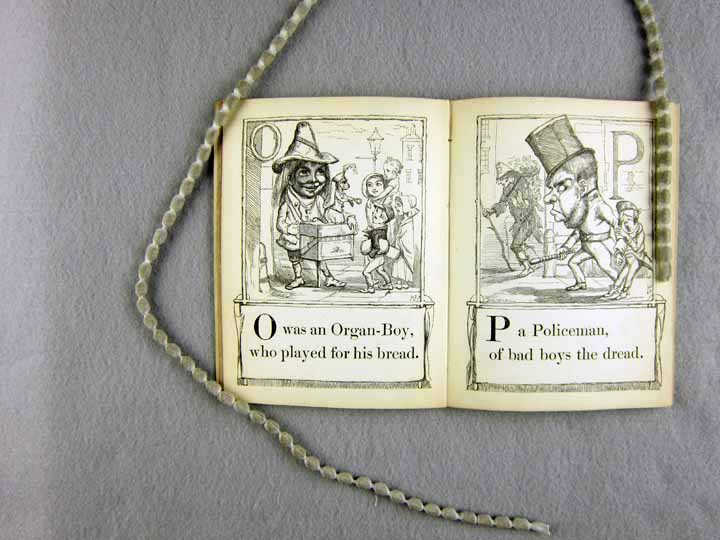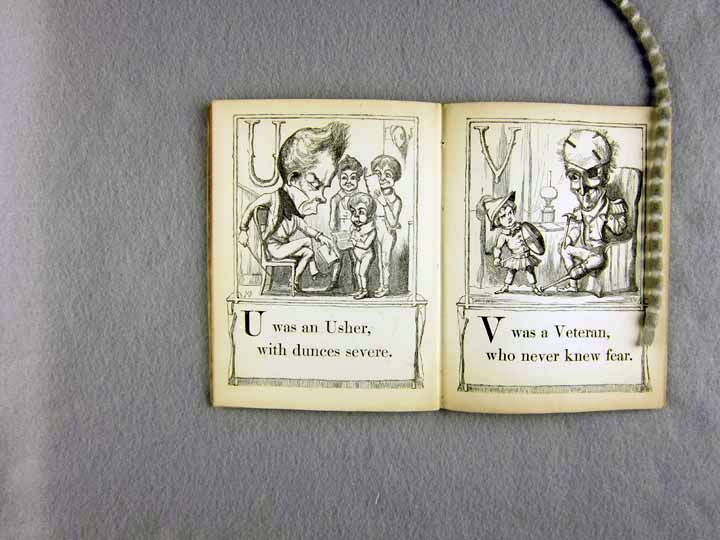

Alphabet books offer a vivid insight into the history of literacy and culture, as well as concepts of childhood. The Children's Book Collection at UCLA contains a rich array of these materials, some well-worn and much-used, some still bright and fresh. Each is a gem of print production and graphical imagery from another time and place. Though the history of alphabet books continues to the present, this exhibit focuses on the works in our collections published between 1700 and 1900, including horn books, primers, works of didacticism and seriousness, whimsy and play.
2. A Jumble ABC
3. A Little Pretty Pocket-Book
4. A New Lottery Book of Birds And Beasts
5. A Pretty Play-Thing for Children of All Denominations
8. ABC of Objects for Home And School
10. ABC with Pictures & Verses
12. Alphabet Et Instruction Pour Les Enfans
16. Dolly's ABC Book
17. Flora's ABC
18. Home ABC
22. Hornbook C. 1700
23. Large Letters for the Little Ones
24. Little ABC Book
25. Little People: An Alphabet
26. Martin's Nursery Battledoor
27. Mother Goose ABC
28. My Darling's ABC
29. Orbis Sensualium Pictus Quadrilinguis
30. People of All Nations: A Useful Toy for Girl Or Boy
31. Picture Alphabet
32. Pretty ABC
33. Railway ABC
34. Rusher's Reading Made Most Easy
38. The Alphabet of Old Friends
40. The Amusing Alphabet for Young Children Beginning To Read
42. The Child's Christian Education
45. The Easter Gift
47. The Favorite Alphabet for the Nursery
49. The Franklin Alphabet And Primer
51. The Golden ABC
55. The Moral And Entertaining Alphabet
57. The Old Testament Alphabet
59. The Picture Alphabet for Little Children
62. The Sunday ABC
63. The Union ABC
64. The Young Child's ABC, Or, First Book
65. Tom Thumb's Alphabet: Picture Baby-Books
67. Warne's Alphabet And Word Book: with Coloured Pictures
68. Wood's Royal Nursery Alphabet
Title Tom Thumb's Alphabet: Picture Baby-Books






Brief description This alphabet books includes the well-used rhyme A is for Archer. W. McConnell's illustrations were engraved for the book by the Brothers Dalziel, a popular engraving firm in the Victorian era who worked with many famous illustrator. The cover of the book is printed on red and blue over boards.
Full description This book begins with the famous alphabetic rhyme "A is for Archer." The text through the book personifies the alphabet, associating each letter with a figure of social, urban life. The expressive illustrations add life to the textual personifications depicting each social character in detail scenes of urban interaction. The book naturalizes the alphabet, casting it as a code essential to understanding social class and personal interactions.
Literacy In Tom Thumb's Alphabet, there is a striking difference between the simplicity of the text and the complexity of the visuals. The text consists of one-syllable words and each letter is clearly emphasized both visually and syntactically. This simplicity assumes that the reader has not mastered alphabetic literacy yet. However, the text is woven into a larger image that implies a complex sense of visual literacy. Each letter and the accompanying text are directly paired with an image and encompassed an illustrative border of branches. The images are complex illustrations that use facial features to convey meaning. Understanding these images requires a high level of social literacy to interpret the interactions among figures as expressed in visual terms. Furthermore, the letters are not self-evident within the images, but are integrated into the scene becoming part of the visual and social landscape. For example, in the image for the letter A, the A is expressed in the figure of a tree in the background of the image. This book assumes that readers will be more comfortable reading in visual terms. Readers may be familiar with visual literacy skills based on the use of graphic symbols in urban signage. Visual literacy is used as a tool to begin to teach alphabetic literacy, affirming the principle that letters are essential symbols that have been assigned a meaning within a social context.*Publishers of the early 19th century flourished with a more efficient distribution network thanks to newspaper routes that were embedded into London's daily lives
Childhood In the world of Tom Thumb's Alphabet, children have rich in internal lives that help make up the social fabric of the community. Nine of the illustrations in the book feature children, and each displays complex emotional qualities through facial expressions. These emotional qualities emphasize the individual nature of children, which may suggest that flexible curriculums designed to meet individual student's needs are the best way to teach children. This point is further supported by two illustrations that subtly criticize public education. The illustration for "U was an usher with dunces severe," depicts the usher, or schoolmaster's apprentice, with a stern look on his face and a rod in his hand as he watches three boys read. This image references the violence schoolmasters frequently used while teaching. The book suggests that this cruelty has the power to stunt education and lead to children's fear of reading in the image for "Y was a youth who did not like school," which depicts a crying young boy being dragged to the academy by an unhappy mother. In contrast, this book romantically conceptualizes literacy as a state that children come to through natural development. The title page of the book features a vignette of an infant nestled in a rosebud with book in hand, an image that visualizes reading as a natural processes. The letters in the text are formed out of tree branches, and they are organically placed within the image reinforcing the naturalized idea of literacy. In Tom Thumb's Alphabet, children are individualized characters in need of the freedom necessary to naturally develop literacy skills that meet their own personal needs.
Iconography Tom Thumb's Alphabet portrays the iconography of an urban culture, depicting the variety of social classes within the urban landscape. Many of the images show vignettes of urban life including street vendors and beggars. For example, "O is for Organ boy" shows a young boy playing an instrument on the street in an attempt to earn some money from passersby. In the image for "I is for Italian," a young, door-to-door peddler is shown trying to sell a caged mouse to the Italian immigrant. Like the organ boy image, this image displays the struggle of survival in urban life and the need to be resourceful in order to find a means of income. The image also references the diverse population of urban life by depicting an Italian immigrant in a British community. The book includes "Q is for Quaker," referencing religious diversity as well. The image for "X is for expensive," shows a wealthy white man being served by an African slave. This image indicates a global world of imperialism. Within the urban community depicted, only some of the figures, such as the wealthy man in "X is for expensive," have access to the successes of an extensive empire. Most of the characters in the text are like the organ boy and mouse peddler, struggling to survive within the urban community. The culture iconography in the book prepares children for the wide range of characters the will be exposed to the urban world regardless of their own place within the class and economic structure.
Production David Bogue published Tom Thumb's Alphabet in London sometime after 1860. David Bogue was a publisher and bookseller who worked with Charles Tilt, the principle publisher of George Cruikshank's work. Bogue began as clerk in Tilt's shop at 86 Fleet Street, and eventually became Tilt's partner and then bought him out. Tom Thumb's Alphabet was illustrated by W. McConnell and engraved by the Brothers Dalziel. The Brothers Dalziel were prolific Victorian engravers that worked with a wide variety of artists and cut the illustration's for Lewis Carroll's Alice in Wonderland and Through the Looking Glass. Each of the illustrations is signed with the artists and engravers' name. The illustrations in this book are black and white engravings, however George Routledge & Sons also published a similar book with the same illustrations done in chromolithography after 1870.
Publication place 86 Fleet Street, London
Date 1860
UCLA Call Number CBC GR486 .T59 1860
Repository UCLA Charles E. Young Research Library, Dept. of Special Collections
Dimensions 18 cm, height
Technologies of production Engraving
Media and Materials Paper
Additional Information Illustrator: McConnell, William, 1833-1867., Dalziel, Edward, 1817-1905., Dalziel, George, 1815-1902.